Ben Miller
Source - http://www.culture24.org.uk/history-and-heritage/archaeology/art499165-Archaeologists-find-beer-and-pizza-ovens-from-northampton-brewery-800-years-ago
Ovens from 800 years ago are at the centre of the latest discoveries in an archaeological dig spanning the centuries in Northampton

The malting oven was ceremonially loaded on to a truck and taken to the nearby brewery
A section of a medieval malting oven, used to make beer 800 years ago and found during a dig to create a new council headquarters in Northampton, has gone on public show at a brewery.
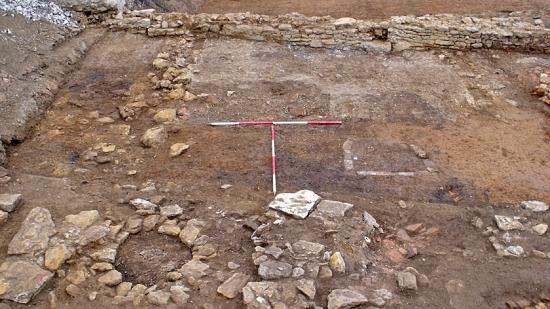
Large pits were dug out during the 15th and 16th centuries to dispose of domestic waste
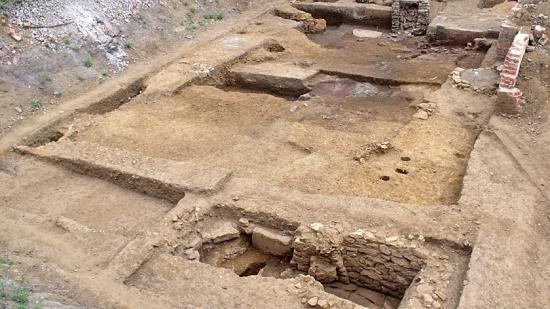
Experts say the discovery of an oven represents 800 years of beer-making in Northampton
The kilns would have been used to dry malt by a company which also owned a communal bread oven on St John’s Street in the town centre.
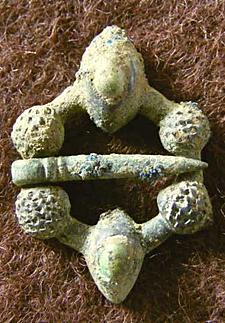
Late medieval copper alloy brooch and pin© MOLA
An archaeological open day to show off key discoveries made during the excavation, which began in early 2014, led to the Phipps brewery asking to put the oven on display. “One of the biggest finds, from an historical point of view, was the uncovering of a malting oven, which was used for the roasting of barley for the production of beer and is believed to date back to the 13th century,” said a council spokesperson. “Last week, another malting oven was found on the site dating from the same period, indicating that beer production was on quite a large scale, rather than just a domestic practice. “The county council also presented Phipps with some stones from the first malt oven, which will be displayed in the brewery premises.”
A tiny late Saxon carved bone dress pin, a late medieval copper alloy brooch and pin, a 15th century Tournai ‘Shield of France’ type jetton and a two-metre stone-lined pit have been among the highlights of a project which saw its first phase of excavation, in the Fetter Street area, completed before Easter.
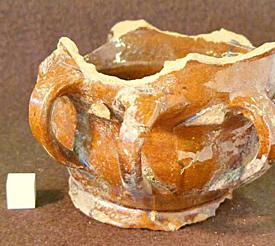
A post-medieval 'puzzle-cup'© MOLA
A puzzle cup – named because only one of its arms would allow its holder to drink from it without spilling liquid – has also been found by Museum of London Archaeology experts who have focused on finding remains from the St John’s Street frontage since resuming their work in early May.
“Prior to the Norman Conquest in the 11th Century, the Fetter Street area was mostly open land,” said the spokesperson. “During recent excavations, archaeologists discovered a cluster of three pits, which produced a small amount of late Anglo Saxon pottery, pre-dating the Conquest, and an attractive Saxon carved bone dress pin with an octahedral head. “After the Norman Conquest, a period of urban expansion followed with the formation of the Norman New Boroug. “Growth within the New Borough appears to have been gradual, probably beginning with occupation along the principal axial roads and then extending to side streets, which included Angel Street, Fetter Street and St John’s Street.

A possible late medieval stone-lined pit© MOLA
“By the middle of the century it seems likely that a few cottages may have been built on the site. “Among the earliest features found is a stone-built bread oven, which would have been used in a similar fashion to a modern-day stone-baked pizza oven – building a fire in the heart of the oven to heat the structure and then raking out the embers before baking. “The oven was heavily damaged by later quarrying that robbed away much of its stone by the mid-13th century.”
Several locally-made pottery jugs have been recovered from two medieval wells in an area which was quarried between the late 12th and early 14th centuries, creating large pits in an area with Jurassic sandstone and iron geology resulting in “excellent” and “colourful" building stone, according to experts.
“Household waste found in the top of the quarry pits includes butchered animal bone, broken domestic cooking pots and storage jars, together with industrial waste from a nearby tannery,” added the spokesperson.
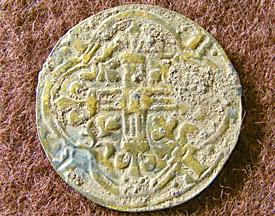
A Tournai 'Shield of France' type jetton, reverse (1400-1478)© MOLA
“Among the rubbish was a small brooch, perhaps lost by one of the labourers during the backfill. “Tanning and leatherwork were important industries for Northampton and were confined to less desirable land on the edge of the town, and preferably down-wind, as the tanning process involves cess and urine. “Evidence for both was found in pits discernible from a green-tinge to the soil. One stone-lined pit is pictured below which had been built on top of the earlier quarries. “Several other large pits were also dug out during the 15th and 16th centuries, specifically to dispose of domestic waste. The majority of the rubbish was animal bone and organic refuse but also contained pottery and other discarded items useful for dating.”
A small box, held together with iron nails, contained copper alloy objects, hair pins, a small sewing kit and two French trading tokens depicting a dolphin, arms and a cross.
“One such pit contained a small box held together with iron nails. Enclosed was a collection of copper alloy objects including hair pins, a small sewing kit and two trading tokens; both from France, one depicting a dolphin and the other depicting French arms on the obverse, with a cross on the reverse.”
The team have been piecing together the specific layout of local buildings across the centuries, consulting the first map of the town, created by John Speed in 1610, and concluding that terraced properties would have replaced an original building on Fetter Street during the 18th century.
Their timeline has led to two semi-detached brick dwellings built in 1935, the last of which was demolished to make way for a council car park in 1992.